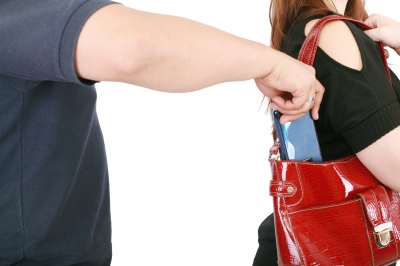Security issue: Pickpocketing
Pickpocketing is a form of theft that involves the stealing of valuables from a victim without their noticing the theft at the time.
Contents
Description
Pickpocketing is a issue that is especially present in large cities, where crowds of people are omnipresent and distractions are plentiful. Although, Barcelona and Rome were recently singled out as being particularly dangerous pickpocketing havens.[1][2][3], pickpockets may be found in any crowded place around the world.
Contributing circumstances
Known circumstances to influence the likelihood or effect of burglary, are presented in the table below:
| Contributing Circumstance | Influence | Description |
|---|---|---|
| Lack of surveillance. | Decreases risk of detection. | A low level of surveillance, particularly round-the-clock surveillance, decreases the perceived risk of detection for a perpetrator and thereby increases the attractiveness. |
| High levels of pickpocketing in the vicinity. | Increases likelihood of targetting. | The distance to known places where offenders live matters. On average, burglars travel 2,6 km to commit their crimes[4] and the odds of a neighbourhood’s being chosen increases by a factor of 1.67 for every kilometre closer to the burglar’s home it is located[5]. |
| High levels of unemployment | Increases likelihood of targetting | High levels of unemployment are associated with higher levels of burglary[6]. In fact a study showed that increased unemployment in one year predicted increased violence in the next year[7]. |
| Presence of crowds or busy places | Some areas are very tempting for pickpockets, such as:
| |
| High expected levels of drug- or alcohol abuse | Reduces inhibitions for crime | The presence of regular abusers of alcohol or drugs has a strong correlation with the occurrence of burglary, often thought to be caused by the need for financing an addiction. Studies show that about 40% of all burglary is committed under the influence of alcohol[8]. |
| Long reaction times or inadequate action of reaction force. | Decreases likelihood of apprehension | Untimely or inappropriate reactions to violence lead to a perception of little control, which will increase perceived risk for the public and decrease perceived risk for the perpetrators. Also, reducing the impact of an assault (by timely intervention) will also be impossoble and lead to greater effects of incidents. |
| Presence of entertainment facilities | ||
| Concentrations of alcohol-serving establishments | ||
| Presence of tourists |
The most significant factor in the victim profile possibly may be psychological. A crowded terminal creates a distracting environment. People are packed together in cramped waiting areas listening for public announcements, watching a departure, carrying packages, or talking on a cellular telephone. The station's environment creates a sensory overload. Further, the victims, conditioned by the rush hour atmosphere of the station, are accustomed to the close physical proximity of other people. Those who use mass transit expect to be bumped and jostled. The victim also expects to have even less personal space when descending the escalators and riding the train, focusing more on boarding the train and finding a seat than being concerned with others.[9]
Impacts
=Social impact
- perception of unsafety
Economic impact
Property crimes such as pickpocketing lead to considerable costs in both a direct (primary) and a indirect (secondary) way[10]. Direct costs of pickpocketing come in the form of:
- Preventive costs in anticipation of pickpocketing (e.g. security measures, prevention, insurance fees);
- Material and immaterial costs as a consequence of pickpocketing (e.g. physical damage, repairs, mental harm); and
- Responsive costs to pickpocketing (e.g. the costs of detection and prevention, persecution, support trial, etc.).
In addition, pickpocketing on a large scale could lead to secondary economic impact, but these effects are relatively minor compared to more serious types of crime.
Mobility impact
Safety impact
Measures
Footnotes and references
- ↑ "Barcelona, pickpocket capital of the world ", The Daily Mail, September 25, 2009
- ↑ "Italy - #1 for Pickpockets", WorldNomads.com, October 20, 2011
- ↑ "TRIPADVISOR POINTS OUT TOP 10 PLACES WORLDWIDE TO BEWARE PICKPOCKETS", TripAdvisor, September 10, 2009
- ↑ Rhodes, W. M., & Conly, C. (1981). Crime and mobility: An empirical study. In P. J. Brantingham, & P. L. Brantingham (Eds.), Environmental Criminology (pp. 167–188). Beverly Hills7 Sage.
- ↑ Bernasco Wim and Nieuwbeerta Paul, How do residential burglars select target areas? A new approach to the analysis of Criminal Location Choice, Brit. J. Criminol. (2005) 44, 296-315
- ↑ Kepple NJ, Freisthler B., Exploring the ecological association between crime and medical marijuana dispensaries.,J Stud Alcohol Drugs. 2012 Jul;73(4):523-30
- ↑ Farrington David P., Langan Patrick A., and Tonry Michael, Cross-National Studies in Crime and Justice, September 2004, NCJ 200988, pag. 26
- ↑ Greenfeld, Lawrence A, Alcohol and crime, an analysis of national data on the prevalence of alcohol involvement in crime, U,.S. Department of Justice, Office of justice Programs, April 5-7 1998, Washington D.C.
- ↑ http://findarticles.com/p/articles/mi_m2194/is_12_72/ai_112799969/
- ↑ Primary economic impact (or direct effects) are generally defined as the initial, immediate economic output generated by a specific cause (in this case a criminal offence). Secondary economic impact (or indirect effects) are generated each time a subsequent transaction is made, for example, the impact of crime on the real estate value in the neighbourhood.
